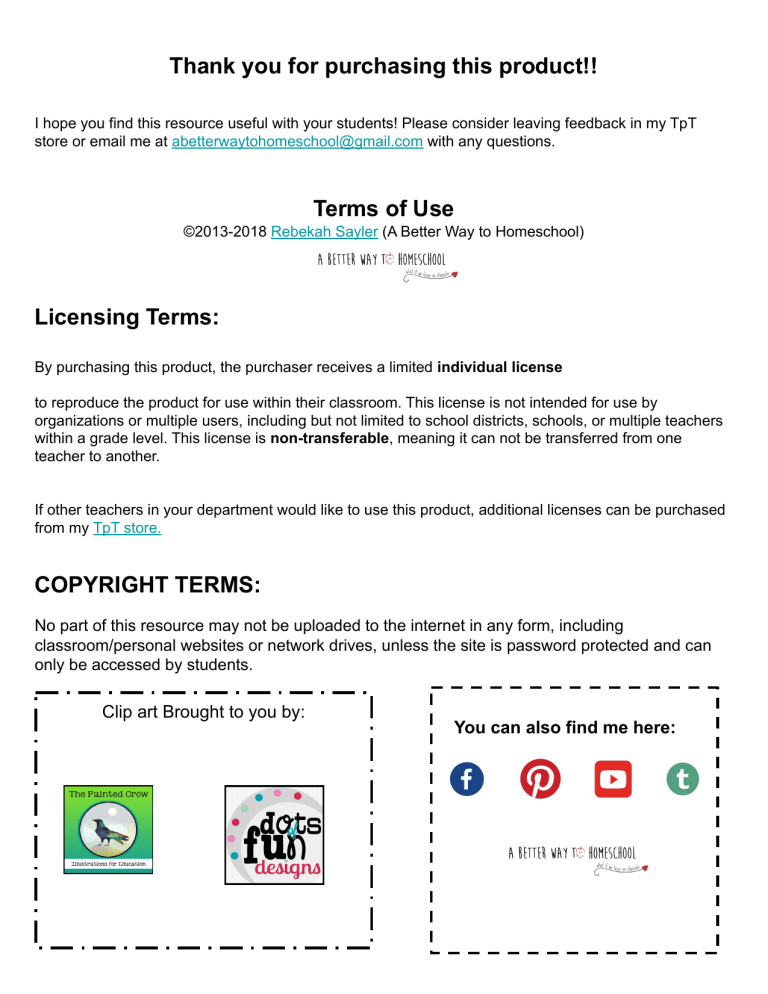
Thank you for purchasing this product!! I hope you find this resource useful with your students! Please consider leaving feedback in my TpT store or email me at abetterwaytohomeschool@gmail.com with any questions. Terms of Use ©2013-2018 Rebekah Sayler (A Better Way to Homeschool) Licensing Terms: By purchasing this product, the purchaser receives a limited individual license to reproduce the product for use within their classroom. This license is not intended for use by organizations or multiple users, including but not limited to school districts, schools, or multiple teachers within a grade level. This license is non-transferable, meaning it can not be transferred from one teacher to another. If other teachers in your department would like to use this product, additional licenses can be purchased from my TpT store. COPYRIGHT TERMS: No part of this resource may not be uploaded to the internet in any form, including classroom/personal websites or network drives, unless the site is password protected and can only be accessed by students. Clip art Brought to you by: You can also find me here: Freebie Enjoy!! Name: _____________________________________ Date: ______________________________________ Plate Boundaries The movement of tectonic plates is most evident at the boundaries between the plates. There are three main types of boundaries: Convergent Boundaries - A convergent boundary is where two tectonic plates push together. Sometimes one plate will move under the other. This is called subduction. Although the movement is slow, convergent boundaries can be areas of geological activity such as the forming of mountains and volcanoes. They can also be areas of high earthquake activity. Divergent Boundaries - A divergent boundary is one where two plates are getting pushed apart. The area on land where the boundary occurs is called a rift. New land is formed by magma pushing up from the mantle and cooling as it reaches the surface. Transform Boundaries - A transform boundary is one where two plates slide past each other. These places are often called faults and can be areas where earthquakes often occur. Word bank: Asthenosphere Crust Plate Transform Boundary Divergent Subduction Convergent Lithosphere tectonics https://www.teacherspayteachers.com/Store/Rebekah-Sayler Name: _____________________________________ Answer key Date: ______________________________________ Plate Boundaries The movement of tectonic plates is most evident at the boundaries between the plates. There are three main types of boundaries: Convergent Boundaries - A convergent boundary is where two tectonic plates push together. Sometimes one plate will move under the other. This is called subduction. Although the movement is slow, convergent boundaries can be areas of geological activity such as the forming of mountains and volcanoes. They can also be areas of high earthquake activity. Divergent Boundaries - A divergent boundary is one where two plates are getting pushed apart. The area on land where the boundary occurs is called a rift. New land is formed by magma pushing up from the mantle and cooling as it reaches the surface. Transform Boundaries - A transform boundary is one where two plates slide past each other. These places are often called faults and can be areas where earthquakes often occur. Word bank: Asthenosphere Crust Plate Transform Boundary Divergent Subduction Convergent Lithosphere Tectonics https://www.teacherspayteachers.com/Store/Rebekah-Sayler More Geology Fun ! Digital Geology S E Y Activities SAVE with the Mega Bundle






